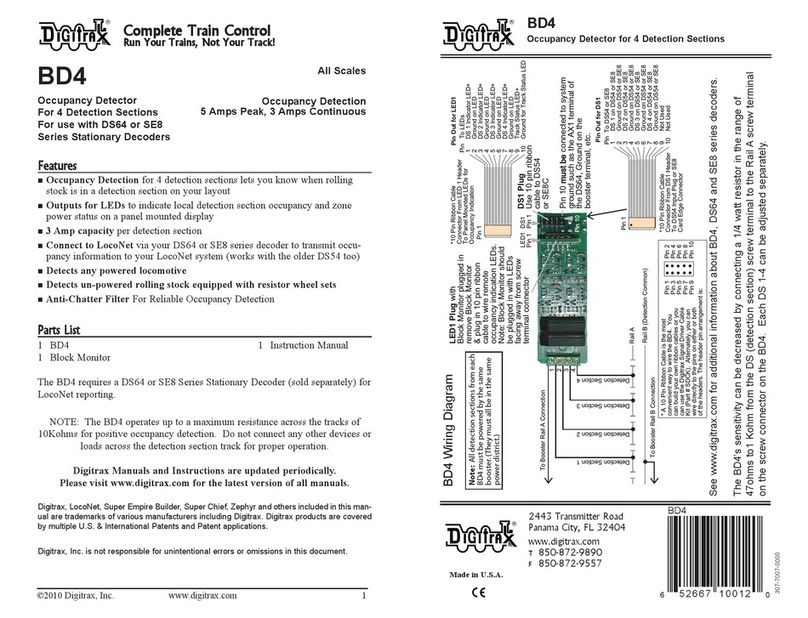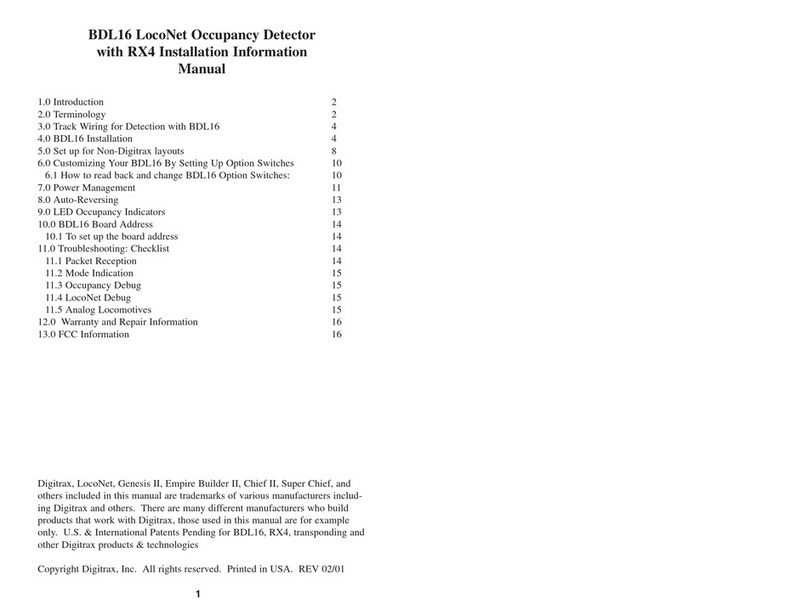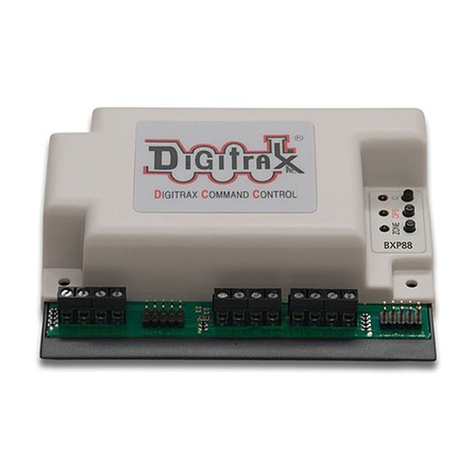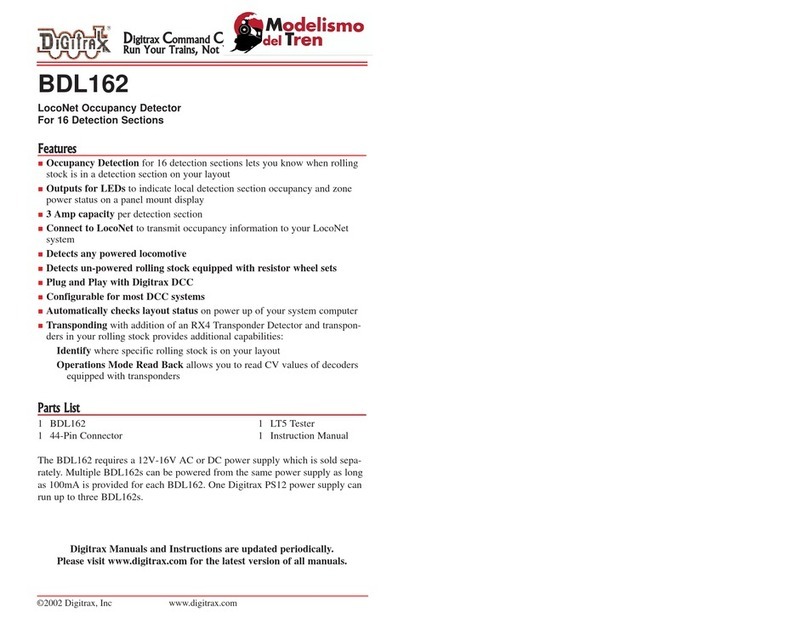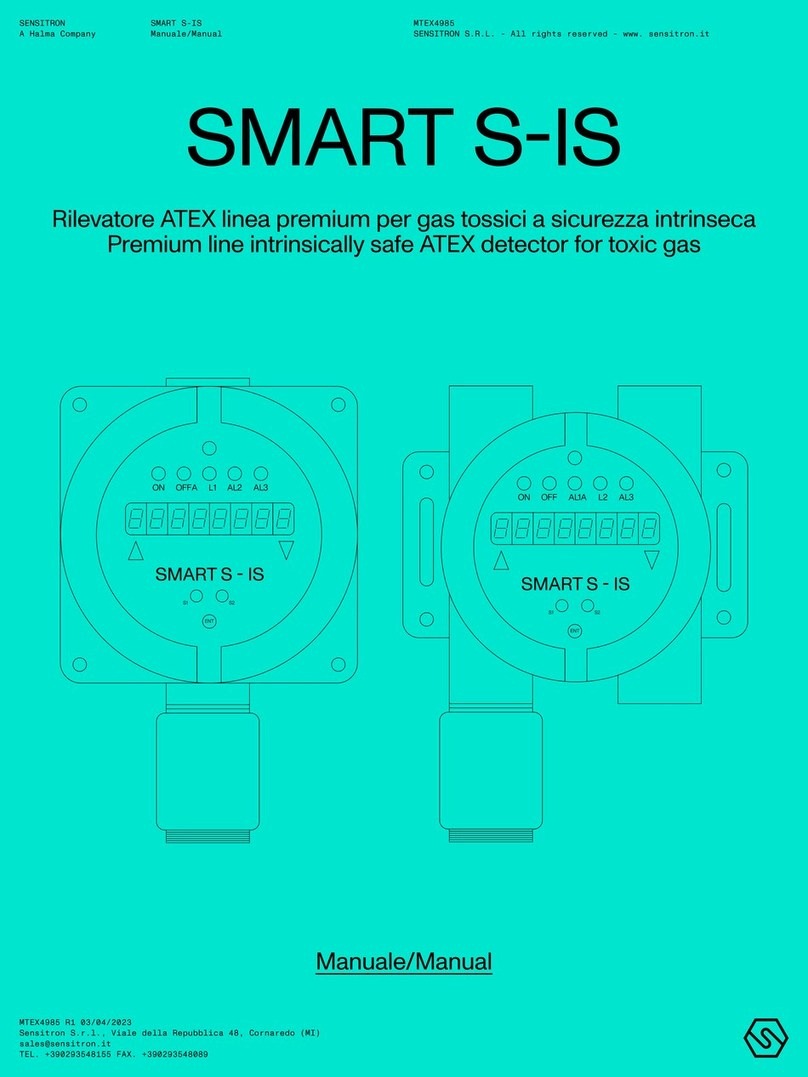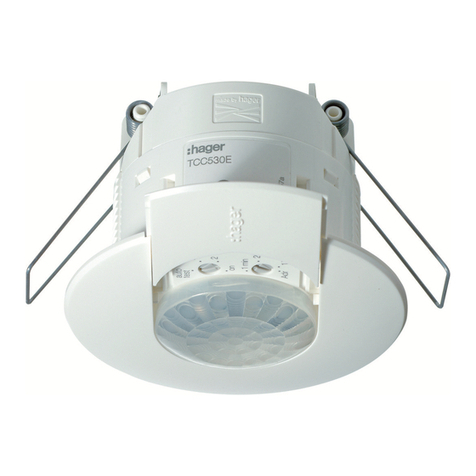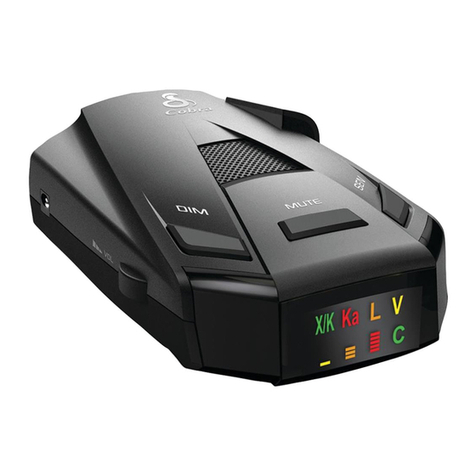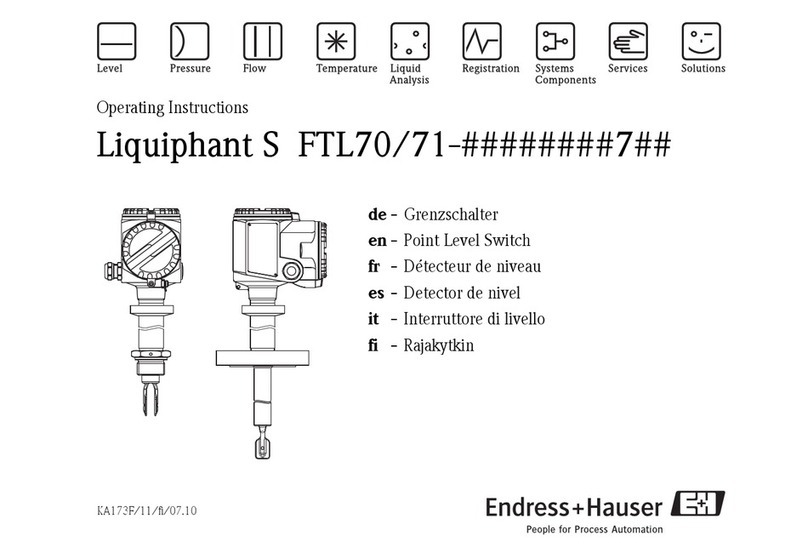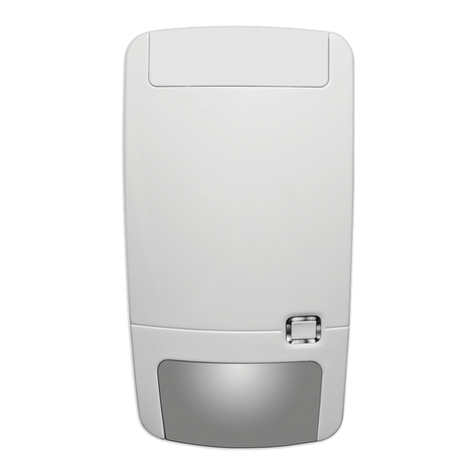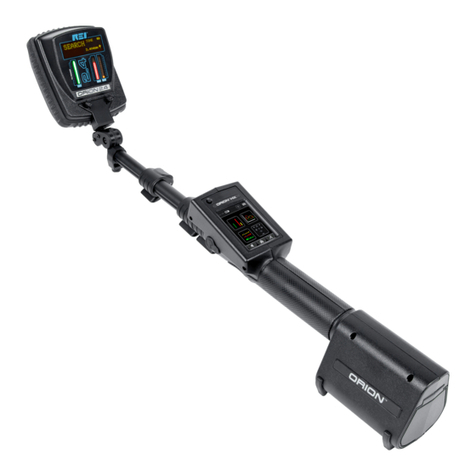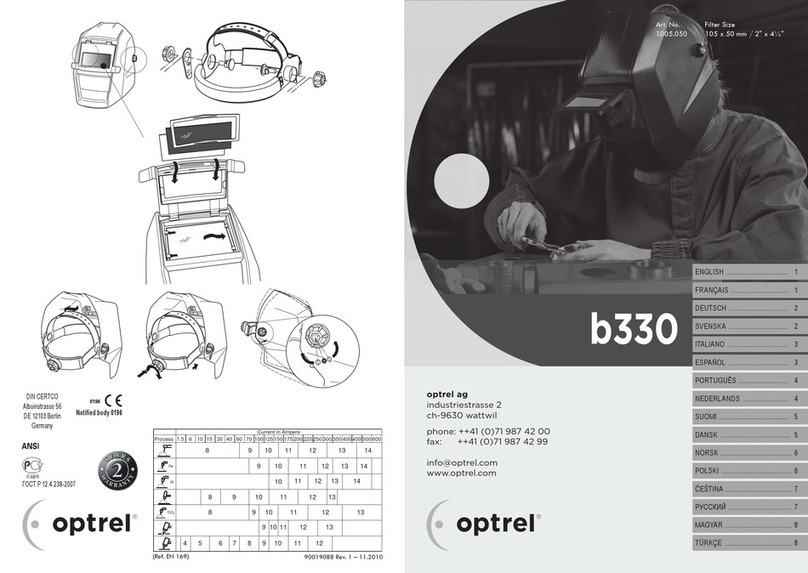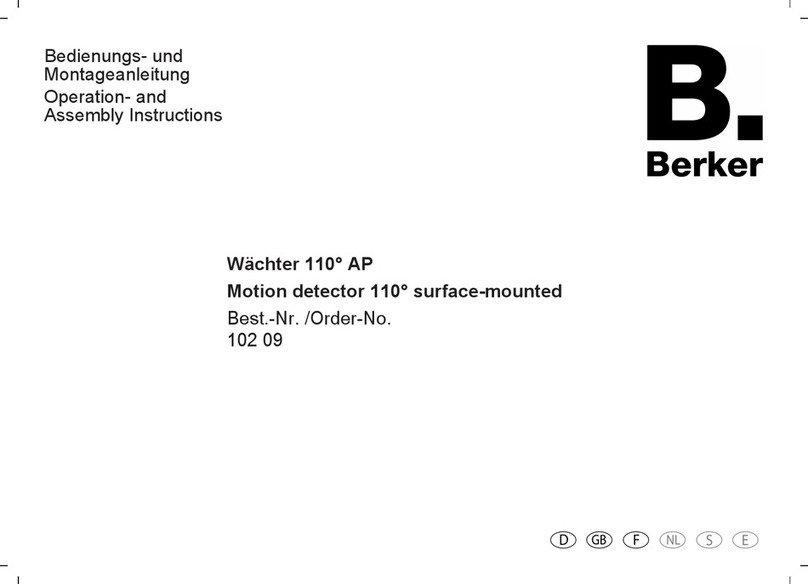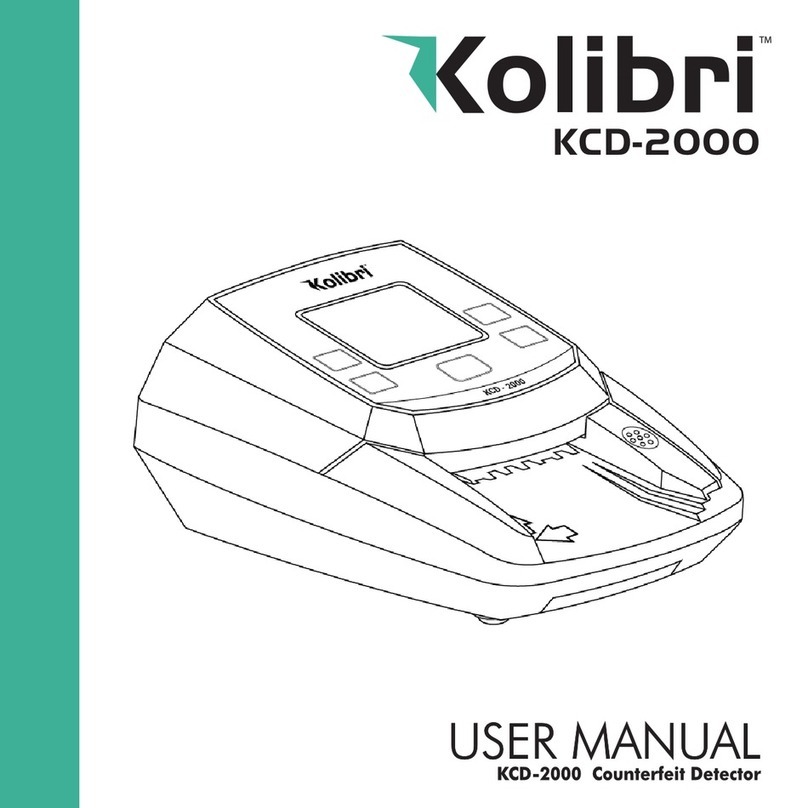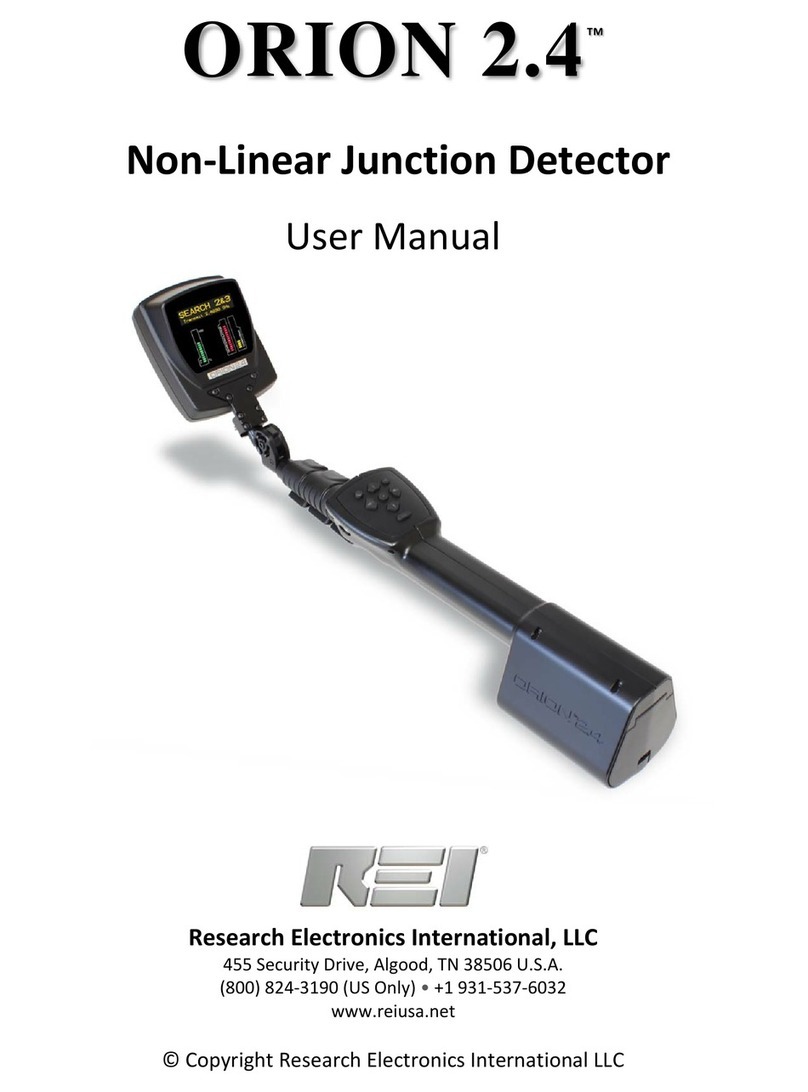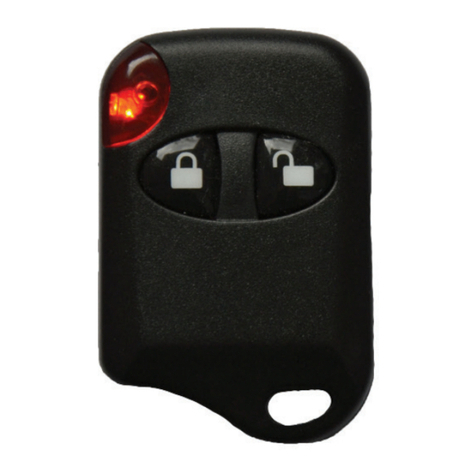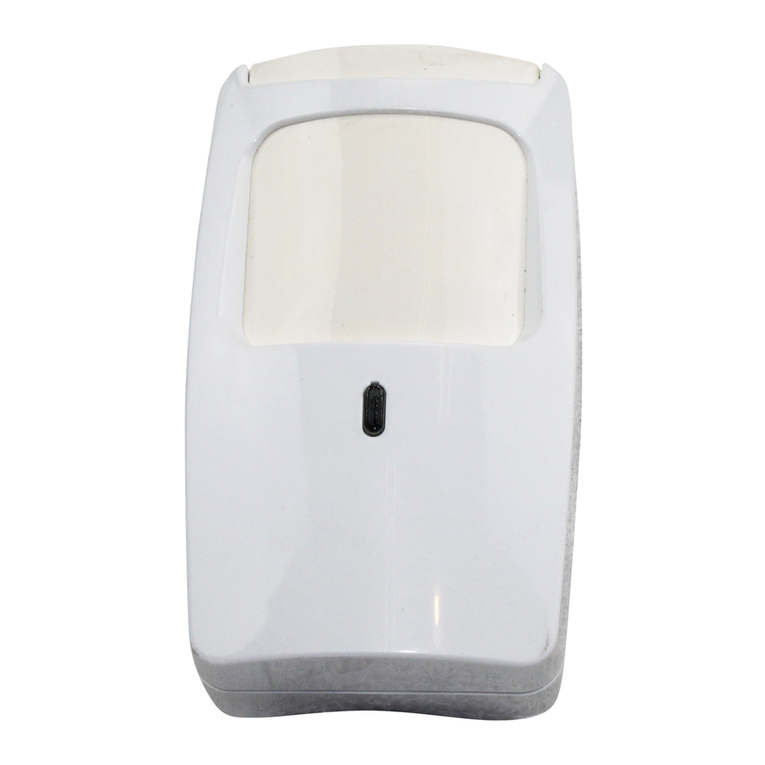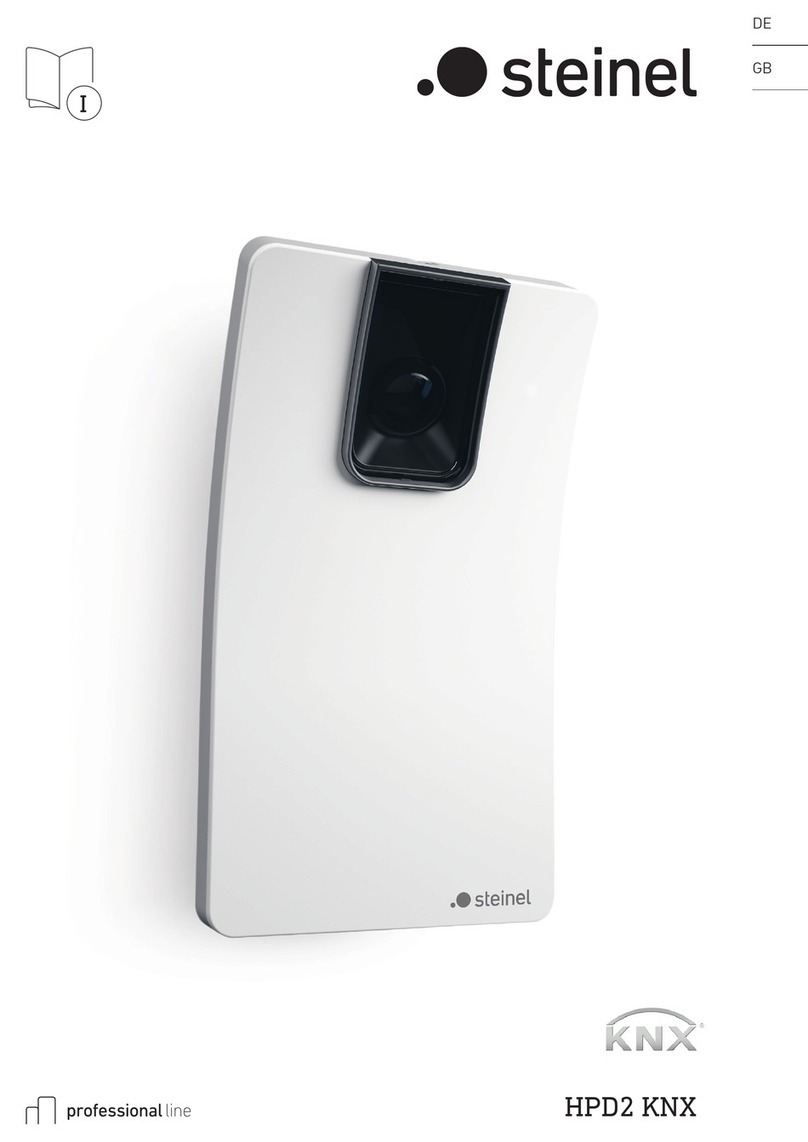Digitrax BDL168 User manual

BDL168
LocoNet Occupancy Detector
For 16 Detection Sections and up
to 8 Transponder Zones
F
Fe
ea
at
tu
ur
re
es
s
nOccupancy Detection for 16 detection sections lets you know when rolling
stock is in a detection section on your layout
nOutputs for LEDs to indicate local detection section occupancy and zone
power status on a panel mount display
n3 Amp capacity per detection section
nConnect to LocoNet to transmit occupancy information to your LocoNet
system
nSupports SuperSonic Decoder Operations
nDetects any powered locomotive
nDetects un-powered rolling stock equipped with resistor wheel sets
nPlug and Play with Digitrax DCC
nConfigurable for most DCC systems
nAutomatically checks layout status when computer software is running at
layout power on
nImproved Rail Sync Sampling for reliable operation
nTransponding with addition of one or two RX4 Transponder Detectors and
transponders in your rolling stock provides additional capabilities:
Identify where specific rolling stock is on your layout
Operations Mode Read Back allows you to read CV values of decoders
equipped with transponders
P
Pa
ar
rt
ts
sL
Li
is
st
t
1 BDL168 1 LT5 Tester
1 44-Pin Connector 1 Instruction Manual
The BDL168 requires a 12V-16V AC or DC power supply which is sold sepa-
rately. Multiple BDL16 series detectors can be powered from the same power
supply as long as 100mA is provided for each BDL16 series detector. One
Digitrax PS12 power supply can run up to three BDL16 series detectors.
Digitrax Manuals and Instructions are updated periodically.
Please visit www.digitrax.com for the latest version of all manuals.
©2004 Digitrax, Inc www.digitrax.com
D
Di
ig
gi
it
tr
ra
ax
xC
Co
om
mm
ma
an
nd
dC
Co
on
nt
tr
ro
ol
l
R
Ru
un
nY
Yo
ou
ur
rT
Tr
ra
ai
in
ns
s,
,N
No
ot
tY
Yo
ou
ur
rT
Tr
ra
ac
ck
k!
!
All Scales

©2004 Digitrax, Inc www.digitrax.com 1
BDL168 LocoNet Occupancy Detector
Manual
TABLE OF CONTENTS
1.0 Introduction ..................................................................................2
2.0 Terminology ..................................................................................2
3.0 Track Wiring for Detection with BDL168..................................4
3.1 Direct Home Wiring........................................................................4
3.2 Common Rail Wiring......................................................................7
4.0 BDL168 Installation Requirements ............................................6
5.0 BDL168 Installation for Digitrax layouts ..................................8
5.1 Direct Home Wiring........................................................................8
5.2 Common Rail Wiring......................................................................9
6.0 BDL168 Installation for Non-Digitrax Layouts........................11
7.0 Customizing Your BDL168 -- Setting Up Option Switches ....12
7.1 How to read back and change BDL168 Option Switches: ..........12
8.0 BDL168 Board Address ..............................................................14
8.1 To set up the board address ..........................................................14
9.0 Auto-Reversing............................................................................14
10.0 Power Management ....................................................................16
11.0 Occupancy Indication ................................................................16
11.1 LocoNet Devices ..........................................................................16
11.2 LT5 Tester......................................................................................17
11.3 Panel Indicator ..............................................................................16
12.0 Transponding with the BDL168 ................................................18
13.0 Troubleshooting: Checklist ........................................................18
13.1 Packet Reception ..........................................................................18
13.2 Mode Indication ............................................................................18
11.3 Occupancy Debug ........................................................................18
11.4 LocoNet Debug ............................................................................19
11.5 Analog Locomotives ....................................................................19
14.0 FCC Information ........................................................................19
15.0 Warranty and Repair Information............................................20
Digitrax, LocoNet, Super Empire Builder, Super Chief, Zephyr and others included in this
manual are trademarks of various manufacturers including Digitrax. U.S. & International
BDL168, RX4, transponding and other Digitrax products & technologies are covered by US
Patent #s 6,275,739, 6,220,552, 6,318,678, 6,533,223 and others including patents pending.
Digitrax, Inc. is not responsible for unintentional errors or omissions in this document.

©2004 Digitrax, Inc www.digitrax.com 2
©2004 Digitrax, Inc www.digitrax.com 2
1
1.
.0
0I
In
nt
tr
ro
od
du
uc
ct
ti
io
on
n
The BDL168 lets you know when a detection section on your layout is occu-
pied. This occupancy detection capability is the first step toward prototypical
control of your rolling stock, signaling, realistic surround sound effects and
realistic modeling of your layout. Installing the BDL168 on your layout is easy
and will make more prototypical operations possible.
The BDL168 uses digital signal processing (DSP) to give you occupancy
detection for 4 zones, A through D, each with 4 detection sections, for a total of
16 detection sections. The number of BDL168s you use on your layout is deter-
mined by how many areas of track you want to monitor and how automated
you want your layout to be--more detection sections require more BDL168s.
On your Digitrax system, the BDL168 reports detection section occupancy to
the system via its LocoNet connection. This makes occupancy information
available for use by any LocoNet device hooked up to LocoNet. For instance,
the information can be used by the SE8/SE8c to set signals or by a computer
program for dispatch control. A BDL168 can also host up to two transponder
detectors like the RX4 to let you implement Digitrax transponding for addition-
al dispatcher control, surround sound or more layout automation.
On DCC systems without a Digitrax compatible LocoNet command station, a
BDL168 can operate using only the RailSync DCC signal from most DCC sys-
tems. In this case, the BDL16 can report detection information via a user-
installed LED display panel.
2
2.
.0
0T
Te
er
rm
mi
in
no
ol
lo
og
gy
y
Following are some terms you might find useful as you work with the
BDL168.
Direct home wiring is a layout wiring method where each power district and
its booster is electrically isolated. The track within each power district uses a
"common return" wiring method for occupancy detection and/or power man-
agement. Direct home wiring is the wiring method recommended by Digitrax
for safety reasons & also because it makes detection work more prototypically.
Power district is the power wiring, track, components and equipment attached
to that wiring, driven by a single properly isolated booster. The track for a
power district is double gapped on both ends of the district. The BDL168 is
used to set up detection sections within one or more power districts.
Power sub-district is the wiring, components and equipment that are con-
trolled from both power bus wires by their own power management device, for
example a reversing section controlled by an automated reversing device like
the PM42. Power sub-districts are gapped on both ends.
Detection common is the common return used within a properly electrically
isolated power district for implementing occupancy detection.

©2004 Digitrax, Inc www.digitrax.com 3
Security element is the plant, including track, associated with any reporting,
interlocking and/or signaling for that track section.
Whole layout common rail is a method of wiring layouts where power dis-
tricts and their boosters are connected electrically by a common rail or com-
mon power bus return wire. This method is traditionally used for conventional-
ly controlled layouts. The track feeds for one rail are connected together to one
output of the power pack. The other rail is gapped and the track feeds are con-
nected to the power pack through block control switches. Whole layout com-
mon rail wiring has a disadvantage when it comes to detection systems because
detectors are not able to independently monitor whether zone power is on or
off. There is no way to tell whether occupancy detection is actually working in
any given detection section.
Detection Section is a section of track gapped on one or both rails and con-
nected to an occupancy detector so that the detector can sense the presence of a
loco (or other specially equipped cars) in that section of track.
Occupancy detector is a device that senses the presence of a locomotive (or
specially equipped cars) in a section of track that is set up for occupancy detec-
tion. Occupancy detectors also provide feedback to indicate occupancy. This
feedback may be in the form of a lamp on a control panel or it may be a feed-
back message sent to the system that can be used by other layout devices. Also
called a block occupancy detector on conventional layouts. Detectors are not
covered by the DCC Standards or Recommended Practices.
Transponder is an electronic device that is installed in rolling stock and can be
assigned a unique address. Transponders provide information to transponder
detectors installed on the layout. This lets the system determine in which detec-
tion section the transponder is currently located. Transponders are included in
all current production Digitrax decoders and many older models as well. TL1
& TF4 function only decoders with transponding are available as separate units
that can be added to locos with existing decoders or to other rolling stock with-
out decoders if you want to use them for transponding only and don't need
motor control.
Transponder detector is an electronic device installed in a detection section
on the layout that receives the information broadcast from a transponder. The
transponder detector sends feedback to the system to let it determine the detec-
tion section location of any given transponder at any time. Your BDL168 can
hose one or two RX4s. One RX4 transponder detector can be hosted by a
BDL168; this enables 4 transponder zones on the BDL168. In this case, each
transponding zone may encompass one to four detection sections. Each
BDL168 can host an additional RX4 giving you a total of 8 transponder zones
that can be shared across the available 16 detection sections of the BDL168.
Note When automatic reversing is used there are special considerations in
grouping detection sections and transponder zones within your BDL168.

©2004 Digitrax, Inc www.digitrax.com 4
3
3.
.0
0T
Tr
ra
ac
ck
kW
Wi
ir
ri
in
ng
gf
fo
or
rD
De
et
te
ec
ct
ti
io
on
nw
wi
it
th
ht
th
he
eB
BD
DL
L1
16
68
8
The key to proper wiring for occupancy detection is planning. Your layout will
be divided into detection sections that can range anywhere from several inches
to several feet in length. This process is somewhat subjective, with the number
and length of a detection sections varying depending on your layout, train
length and the purpose of the detection.
It is best to plan your detection sections based upon the operations you want to
accomplish on your layout before cutting gaps in the track and installing the
BDL168. For instance, a grade level signal crossing may require from two to
four different detection sections in order to create the effects you want with the
lights and gates operating for trains traveling in either direction. Signal lights
will require information from two detection sections in front of the signal in
order to function like the prototype. Detection is not only useful but critical if
operating a hidden staging area--occupancy detection will let you know which
tracks are occupied in hidden staging areas. In your initial wiring installation,
not all sections have to be connected to BDL168s; they can be connected to a
terminal strip and then to boosters or power management devices. Additional
BDL168s can then be inserted later as needed to further develop your layout.
Additional information about planning and installing the BDL168 can be found
on the web site in the document: Advanced Transponding Application Note
within the Digitrax Application Notes and Technical Information section of the
site. The form, BDL16 Series Planning Worksheet, is also available in the same
section for documenting your setup for future reference and trouble shooting.
Whether you are building a new layout or installing your BDL168 on an exist-
ing system, there are two basic wiring formats: direct home wiring and whole
layout common wiring.
3.1 Direct Home Layout Wiring
Digitrax strongly recommends direct home wiring where each power district
and its booster are electrically isolated. This method of wiring has safety
advantages and makes troubleshooting problems easier. In addition, direct
home wiring makes detection work more prototypically.
With direct home wiring, the BDL168 can determine and indicate whether any
of its 4 zones is powered or not (possibly short-circuited) even when there is
nothing on the rails in the detection sections. The BDL168 factory set logic
causes the detection sections to show "occupied" if the associated zone's power
is off (because in this case, detection is not possible). This factory setup match-
es typical prototype detection safety practices. Figure 1 shows an example of a
direct home wiring layout with a single power district with multiple detection
sections. zone A with 4 detection sections (1-4) and zone D with one detection
section (16) has been wired in this example.

©2004 Digitrax, Inc www.digitrax.com 5
Figure 1: Direct Home Wiring Example
1 2 3 4 5 6 7 8 9 10 11 12 13 14 15 16 17 18 19 20 21 22
TOP ROW
AB
C
D
RX4-B.
RX4-A
PS12PS12
12V AC12V AC
PowerPower
SupplySupply
Zone Common
(Heavy Wire)
Detection Common
Booster Ground to pin 11
Zone A
DS 1
DS 2
DS 3
DS 4
Zone B
DS 5
DS 6
DS 7
DS 8
Zone C
DS 9
DS 10
DS 11
DS 12
Zone D
DS 13
DS 14
DS 15
DS 16
Booster GND
Ext. Power
BDL168
Top View
Detection Section
1
Detection Section
2
Detection Section
3
Detection Section
4
TRACKTRACK
STATUSSTATUS
POWERPOWER
ONO N
OFF LINEO F F L I N E
O/GO/G
NN
HOH O
MODEMODE
OO
RUNRUN
LOCONETLOCONET
AABBSCALESCALE
SLEEPSLEEP
PP
R
R
R A I L B
RAIL B
P O W E R I N
POWER IN
R A I L A
RAIL A
P O W E R I N
POWER IN
GROUND
GROUND
LocoNet
to other LocoNet
Devices such as
(Throttles, Boosters,
UP5s Etc.)
12V AC to Pin N (bottom row)
12V AC to Pin 12 (top row)
Note: BDL168 Zone A Wiring
shown for clarity. Zones B, C,
and D are wired similarly.
External LED
Connectors (pin 1)
(See Figure 4)
Figure 1: Typical Direct Home Wiring
Direct Home Booster (Digitrax standard)
ID LED (green)
Option LED (red)
Detection Section
16
~
~~
~
ID Switch
Option Switch

©2004 Digitrax, Inc www.digitrax.com 6
Figure 2: Whole Layout Common Rail Wiring Example
1 2 3 4 5 6 7 8 9 10 11 12 13 14 15 16 17 18 19 20 21 22
TOP ROW
AB
C
D
RX4-A
RX4-B
PS12PS12
12V AC12V AC
PowerPower
SupplySupply
Common
Rail Return
Detection Common
Booster Ground
to pin 11
Zone A
DS 1
DS 2
DS 3
DS 4
Zone B
DS 5
DS 6
DS 7
DS 8
Zone C
DS 9
DS 10
DS 11
DS 12
Zone D
DS 13
DS 14
DS 15
DS 16
Booster GND
Ext. Power
BDL168
Top View
Detection Section
1Detection Section
2Detection Section
3Detection Section
15
TRACKTRACK
STATUSSTATUS
POWERPOWER
ONO N
OFF LINEO F F L I N E
O/GO/G
NN
HOH O
MODEMODE
OO
RUNRUN
LOCONETLOCONET
AABBSCALESCALE
SLEEPSLEEP
PP
R
R A I L BRAIL B
P O W E R I N
POWER IN
R A I L A
RAIL A
P O W E R I N
POWER IN
GROUND
GROUND
LocoNet
to other LocoNet
Devices such as
(Throttles, Boosters,
UP5s Etc.)
External LED
Connectors (pin 1)
See Fig. 4
Figure 2: Common Rail Wiring
Opto-Isolated Booster
DS 16 Used as
Zone Power Detector
For Zones 1 thru 15
To other Common Rail
Sections
To other
Common Rail
Sections
Track Detection
uses the Layout
Common Rail
ID LED (green)
Option LED (red)
(Heavy Wire)
Digitrax Special Order or
Other Digitrax Compatible Booster
~
~~
~
10 kohm
Resistor
Note: For this example,
BDL168 OPSW 10 must
be set to "c".
ID Switch
Option Switch
12V AC to Pin N (bottom row)
12V AC to Pin 12 (top row)

©2004 Digitrax, Inc www.digitrax.com 7
3.2 Common Rail Wiring
Whole layout common rail is a method of wiring layouts where power districts
and their boosters are electrically connected using a common rail or common
power bus return wire. Whole layout common rail wiring is a disadvantage
when it comes to detection systems since detectors cannot independently moni-
tor whether zone power is on or off so they can't tell whether occupancy detec-
tion is working in any given detection section. See Figure 2: Whole Layout
Common Rail Wiring for an example of wiring a single power district and
one zone with four detection sections.
4
4.
.0
0B
BD
DL
L1
16
68
8I
In
ns
st
ta
al
ll
la
at
ti
io
on
nR
Re
eq
qu
ui
ir
re
em
me
en
nt
ts
s
The BDL168 wiring panels should be located near the highest feeder density in
order to minimize the lengths of wires feeding from the track to the BDL168.
Planning the detection sections on the layout and the associated wiring on the
wiring panel is covered in more detail in the technical applications paper,
Advanced Transponding Application Note, available at www.digitrax.com. The
paper includes photographs of a sample installation of the BDL162 (predeces-
sor to the BDL168) with associated PM42 and RX4. Figure 3 shows suggested
minimum space requirements for installing a single BDL168 and the optional
RX4 Transponding Detector on a wiring panel. See the RX4 manual for more
information. Allow space on your mounting panel for the terminal strip, addi-
tional BDL16 series detectors and any PM42s required for power management.
1. Drill mounting holes in the end of the 44-pin connector (Figure 3) or mount
using existing holes and right angle brackets.
2. Screw the connector directly to the wiring panel board.
Figure 3: BDL168 Installation Space
BDL168 Mounting Considerations
If you are planning to use Digitrax Transponding with your BDL168
please allow the amount of space shown below to install the
RX4 Transponder Receiver.
Note: These areas should be clear of any other layout wiring and
within 12 inches of the BDL168 for best results.
BDL168
Top View

©2004 Digitrax, Inc www.digitrax.com 8
5
5.
.0
0B
BD
DL
L1
16
68
8I
In
ns
st
ta
al
ll
la
at
ti
io
on
nf
fo
or
rD
Di
ig
gi
it
tr
ra
ax
xS
Sy
ys
st
te
em
ms
s
5.1 Wiring the BDL168 for a Digitrax Direct Home Wiring Layout
1. After mounting the 44-pin connector to the board (see section 4.0), label the
top of the 44-pin connector for easy identification of the wires, using zone
letters (A,B,C,D) and detection section numbers (1-16) (See Figure 1).
Note, these are not the same as the pin identification numbers that are
already molded on the connector. Make sure to double check the connec-
tor orientation before plugging in the BDL168 board to avoid possible
damage that can result if it is plugged in using the incorrect orientation.
Hint: Some users assign each BDL168 board a letter designation to use
with the detection section number for tracking outputs. For example the first
BDL168 board would be “A” and the detection sections connected to it
would be labeled “A1”, “A2”...“A16” on the wiring panel terminal strip, on
the rough layout and on the layout diagram for easier troubleshooting.
2. Solder one wire (AC1) from a 12-16V AC or DC power supply to the pin
12 and the second wire (AC2) from the power supply to the pin N on the
BDL168's 44-pin connector. This powers the BDL168. Multiple BDL168
units can be supplied by a single shared supply as long as you provide at
least 100mA for each BDL168. This power supply should not power any
devices other than BDL168s.
3. Solder the ground wire from the Digitrax booster ground or common (case)
to pin 11 of the 44-pin connector. Nothing is connected to pin M.
4. The end of the wire from each zone common and detection section should
be stripped approximately 1/4” and inserted through the holes in each pin
pair on the connector as indicated in Table 1 and Figure 4. Solder the wire
to each pin. The zone common connections to the booster should be as short
as possible and relatively heavy gauge, since they are common to all four
detectors in the zone. For example, a 12AWG zone connection to the boost-
er should be less than 10 feet for best performance.
5. Plug the BDL168 board firmly into the 44-pin connector.
6. Connect a LocoNet cable into one of the BDL168's LocoNet jacks.
7. Apply power to the unit. The red and green LEDs will light up as power is
applied to the unit. The red LED will go out and the green LED will stay on
and “wink” off once, approximately every 2 seconds, indicating that it is
connected to LocoNet and seeing DCC packets.
The BDL168's option switches are factory set at the values that will work for
most direct home wired layouts. You can fine-tune the BDL168's characteris-
tics using its option switches which can be set using a Digitrax compatible
throttle or a PC with LocoNet compatible software that can control turnouts.
See Section 7: "Customizing your BDL168 By Setting Up Option Switches.”

©2004 Digitrax, Inc www.digitrax.com 9
5.2 Wiring the BDL168 for Whole Layout Common Rail Wiring
Whole layout common rail wiring cannot independently monitor whether zone
power is on or off so it can't tell whether occupancy detection is working or not
in any given detection section. The BDL168 can be easily configured to over-
come this disadvantage by using detection section 16 to monitor track power--
if track power is on in section 16 then detection is working in sections 1-15.
1. After mounting the 44-pin connector to the board (see section 4.0), label the
connector Using the zones and detection section numbers for easy identifi-
cation of the pins when wiring. (See hint on labeling for wire tracing and
troubleshooting under 5.1.1 wiring for direct home wiring systems.)
2. Solder one wire (AC1) from a 12-16V AC or DC power supply to the pin
12 and the second wire (AC2) from the power supply to the pin N on the
BDL168's 44-pin connector. This powers the BDL168. Multiple BDL168
units can be supplied by a single shared supply as long as you provide at
least 100mA for each BDL168. This power supply should not power any
devices other than BDL168s.
3. Solder the ground wire from the Digitrax booster ground or common (case)
to pin 11 of the 44-pin connector. Nothing is connected to pin M.
4. The end of the wire from each detection section and zone common should
be stripped approximately 1/4” and inserted through the holes in each pin
pair on the connector as indicated in Table 1 and Figure 4. Solder the wire
to each pin. The zone common connections to the booster should be as short
as possible and relatively heavy gauge, since they are common to all four
detectors in the zone. For example, a 12AWG zone connection to the boost-
er should be less than 10 feet for best performance.
5. Wire a 10K resistor from detection section 16 (pin 22) to the detection com-
mon return for the whole BDL168 ( Figure 2). Detection section 16 will be
active when the BDL168 sees track power and you will be able to tell
whether detection is actually available in detection sections 1 through 15.
6. Plug the BDL168 board firmly into the 44-pin connector.
7. Connect LocoNet via one of the BDL168's LocoNet jacks.
8. The first time you apply power to the unit, hold down the switch located
behind the red LED on the BDL168 to set it up for whole layout common
rail operation. The red and green LEDs will light up as power is applied to
the unit. The red LED will go out and the green LED will stay on and
“wink” off twice, approximately every 2 seconds, indicating that it is set up
for common rail wiring and that it is connected to LocoNet and seeing DCC
packets.
The BDL168's option switch 10 is set to “c” (closed) to allow detection section
16 to be used to monitor zone power on a whole layout common rail wired sys-
tem. You can fine-tune the BDL168's characteristics using its option switches
which can be set using a Digitrax compatible throttle or a PC with LocoNet
compatible software that can control turnouts. See Section 7: "Customizing
your BDL168 By Setting Up Option Switches.”

©2004 Digitrax, Inc www.digitrax.com 10
Table 1: BDL168 44-Pin Connector Pin Out Configuration
Notes:
1) All connector pins are paired top (component side) and bottom (sol-
der side) except 11/M and 12/N. For 6 Amp current rating with 3 Amp
connector pins, track/zone wires must be connected to both pin pairs:
e.g. Zone A = pins 1 & A (See Figure 4).
2) Letters G, I, O & Q are not used as pin designations on the connector.
3) Power connections should be made to a power supply dedicated to
BDL168 use only. Multiple BDL168 units can be supplied by a single shared
supply as long as you provide at least 100mA for each BDL168.
4) The Ground connection, pin 11, must be made to the booster for correct
BDL168 operation.
Top
Pin
Bottom
Pin
Name
Connect To
1
A
Zone A
Connection to booster for Zone A
2
B
DS 1
Isolated track section for Detection Section 1
3
C
DS 2
Isolated track section for Detection Section 2
4
D
DS 3
Isolated track section for Detection Section 3
5
E
DS 4
Isolated track section for Detection Section 4
6
F
Zone B
Connection to booster for Zone B
7
H
DS 5
Isolated track section for Detection Section 5
8
J
DS 6
Isolated track section for Detection Section 6
9
K
DS 7
Isolated track section for Detection Section 7
10
L
DS 8
Isolated track section for Detection Section 8
11
Ground**
LocoNet/BDL168 ground to Booster
case/common ground
M
Nothing attached to this pin
12
AC Power 1*
Power input to BDL168 : AC 12V to 15V, or
+DC 12V to 15V
N
AC Power 2*
Power input to BDL168 : AC 12V to 15V, or
+DC 12V to 15V
13
P
Zone C
Connection to booster for Zone C
14
R
DS 9
Isolated track section for Detection Section 9
15
S
DS 10
Isolated track section for Detection Section 10
16
T
DS 11
Isolated track section for Detection Section 11
17
U
DS 12
Isolated track section for Detection Section 12
18
V
Zone D
Connection to booster for Zone D
19
W
DS 13
Isolated track section for Detection Section 13
20
X
DS 14
Isolated track section for Detection Section 14
21
Y
DS 15
Isolated track section for Detection Section 15
22
Z
DS 16
Isolated track section for Detection Section 16
Confirm that the 44-pin connector is plugged in to the
BDL168 in the correct orientation to avoid damage to
the BDL168 when power is applied. See Figures 1 or 2
for proper connector orientation.

©2004 Digitrax, Inc www.digitrax.com 11
Figure 4: Connecting Zone & Detection Section Wires to the 44-Pin Connector.
6
6.
.0
0B
BD
DL
L1
16
68
8I
In
ns
st
ta
al
ll
la
at
ti
io
on
nf
fo
or
rn
no
on
nD
Di
ig
gi
it
tr
ra
ax
xL
La
ay
yo
ou
ut
ts
s
To make set up simpler and easier for non-Digitrax layouts to use the BDL168,
there are two quick configuration buttons that let you set up your unit to work
with either direct home or whole layout common rail without using a Digitrax
throttle or computer.
1. If you are using direct home wiring, use Section 5.1 as an example for
wiring detection sections. If you are using whole layout common rail
wiring, use Section 5.2 as an example for wiring detection sections.
2. Connect the left-most pin of the RJ12 socket (the RailSync pin) to Rail A
output of your system.The source of the DCC signal must match the DCC
signal being sent by the booster to the detection sections handled by the
BDL168. It is best that this signal stays active even when the booster output
is shorted or disconnected from the BDL168 zone inputs, for example by a
PM42 Power Manager.
3. Configure the BDL168 for your wiring system
a) For direct home wiring layouts, the “ID” switch behind the green ID
LED is held down when AC power is first applied, the BDL168 will operate
on direct home layouts (the factory setting). When DCC packets are sup-
plied to the RailSync pin of the RJ12 connector the ID LED will be lit and
“wink” off once every 2 seconds to indicate direct home operation is select-
ed.
b) When operating on a whole layout common rail system, the “OPTION”
switch behind the red option LED is held down when AC power is first
applied to the BDL168. When DCC packets are supplied to the RailSync
pin connector the ID LED will be lit and “wink” off twice every 2 seconds
to indicate whole layout common rail operation is selected.
Note: If either switch is pressed when the BDL168 is first powered up, the
BDL168 will be re-configured.
4. To make multiple BDL series detectors work with non-Digitrax DCC lay-
outs, they must be connected via LocoNet. One of the BDL series detectors
must be set up as a master by setting OpSw 11 to thrown (See Section 7 for
information about setting option switches). This allows LocoNet to commu-
nicate occupancy status to a computer.

©2004 Digitrax, Inc www.digitrax.com 12
7
7.
.0
0C
Cu
us
st
to
om
mi
iz
zi
in
ng
gY
Yo
ou
ur
rB
BD
DL
L1
16
68
8-
--
-S
Se
et
tt
ti
in
ng
gU
Up
pO
Op
pt
ti
io
on
nS
Sw
wi
it
tc
ch
he
es
s
The option switches and settings you can use to customize your BDL168 are
indicated in Table 2. These option switches on your BDL168 are set up using a
Digitrax throttle's SWITCH commands. (This can only be done with a Digitrax
LocoNet throttle or equivalent software). SWITCH mode is normally used for
operating turnouts by issuing closed ("c") or thrown ("t") commands. In the
case of your BDL168, each switch address is a BDL168 option switch.
7.1 How to read back and change BDL168 Option Switches (OpSw):
1. Power up your BDL168 and connect it to LocoNet.
2. Connect a DT or UT series Digitrax throttle to one of the the BDL168's
LocoNet connectors.
3. Press the switch behind the red option LED for about 1 second, then release
it. The red option and green ID LEDs will flash alternately to let you know
that you are in option switch setup mode.
4. Go into SWITCH mode on your throttle. Dial up the switch number that
corresponds to the OpSw you want to change and issue a closed "c" or
thrown "t" command to set the OpSw to the desired setting. The OpSw is
changed as soon as you issue the SWITCH command. See below for
instructions for specific Digitrax throttles.
5. When BDL168 OpSws are set up as desired, press the switch behind the red
option LED for about 1 second and release it, the BDL168 will exit option
switch set up mode. You can also exit option switch set up mode by turning
off the power to the BDL168 and then turning it back on.
DT100, DT200 or DT300 series throttle, press MODE/DISP key on the throttle
to enter SWITCH mode. Use the throttle to read back each OpSw in Table 2 by
dialing it up on the throttle and looking at its setting (“c” or “t”) in the display. If
you need to make a change to the OpSw simply press the cor tkey to make the
change you want. Once you are finished reading back and changing settings,
simply wait 6 seconds for the throttle to time out and return to “LOCO” mode.
Be sure to complete step 5 above when finished setting OpSws.
UT series throttle, press the RUN/STOP and DISP/OPSW keys at the same
time to enter SWITCH mode. With a UT throttle, you won't be able to read back
the BDL168 OpSw settings but you can change them by dialing up the OpSw
number you want to modify and pressing the ckey. When the LED under the c
key is on, the OpSw is set to closed; when it is off, the OpSw is set to thrown
(the factory setting). When you are finished setting up BDL168 OpSws, return
to LOCO mode by pressing RUN/STOP and DISP/OPSW keys at the same time.
Be sure to complete step 5 above when finished setting OpSws.
DT400 series throttle, press SWCH key to enter into the switch mode. Use the
keyboard to enter the OpSw number and view the current setting for the OpSw
you want to change (“t” or “c” in the display). Press the tor ckey to change the
setting. To return to “LOCO” mode press the EXIT key.

©2004 Digitrax, Inc www.digitrax.com 13
Table 2: BDL168 Option Switches (OpSw)
The following table shows what each OpSw is used for when it is set for
thrown or closed. Factory settings are indicated by shaded boxes.
Option Switches for BDL168 and RX4.
OpSw
t = thrown
c = closed
01
Set up for operation
with direct home
wired layouts (Digitrax
recommended wiring)
Set up for whole layout
common rail wired layouts
03
Normal BDL LocoNet,
Railsync cable
polarity. (Affects
detection and
changes timing edge
to be used for
transponder
detection)
Reversed BDL LocoNet, Railsync cable
polarity.
(Affects detection and changes timing
edge to be used for transponder
detection)
05*
Disable Transponding
Enable Transponding
06*
RX4 connected
(OPSW6 and 7 MUST
be “t” when RX4
connected)
Do not use
07*
RX4 connected
(OPSW6 and 7 MUST
be “t” when RX4
connected)
Do not use
09
Detection sections
show occupied when
zone power is off
No forced occupied
detection when zone power
is off
10
Use detection section
16 as a normal
detection section.
Use detection section 16 as
zone power ON qualifier for
whole layout common rail
wiring
11
Allow this BDL168 to
be the master.
Do not allow this BDL168
to be master
12
Allow this BDL168 to
terminate LocoNet
Do not allow this BDL168
to terminate LocoNet
13
Power up delay 5
seconds for
DB150 compatibility
Power up delay 1/2 second
19
Use regular threshold
sense DCC
occupancy. (approx
22 Kohms minimum)
Use high threshold sense
DCC occupancy (approx
10 Kohms minimum)
25
16 LEDs show
occupancy
Drive 16 occupancy LEDs
from SWITCH commands
(not occupancy)

©2004 Digitrax, Inc www.digitrax.com 14
Option Switches for BDL168 and RX4 con’t.
Shaded boxes indicate the factory default setting.
OpSw
t = thrown
c = closed
26
Occupancy LEDs
decoded
from track DCC
switch
commands
Occupancy LEDs decoded
from LocoNet SWITCH
commands
36
Refreshes at GPON
Ignore GPON messages and look only at
interrogate commands
37
Standard Detection
Section OFF timing
Slow Detection Section OFF timing (DS
release)
38
Double DS release (if OpSw 37=c)
39*
Disable “Verbose”
transponding mode
Enable “Verbose” transponding mode
(allow same ID in multiple zones
simultaneous)
40
Direct home wiring
compatible
Make all option switches
factory settings
42
Standard Interrogate
Setting
Turn OFF from ignoring the 1st.
interrogate after power up.
Send an update of all DS values each
time power is applied to it, irrespective of
GPON or Interrogate messages
(opsw36)
43*
Standard
Transponding Filter
Disable Transponding Filter
44*
Maximum Transponding Filter
(if OpSw43=t)
45*
Transponding
messages sent at
GPOFF
No Transponding messages are sent at
GPOFF
( * changes only affect transponding)
Suggested BDL168 Settings for Railroad&Co. from European users.
OpSw9 = Closed (No message sent if un-powered)
OpSw36 = Closed (Ignore GPON)
OpSw37 = Closed (Long delays for sensors)
OpSw38 = Closed (Extra long delay for sensors)
OpSw39 = Closed (Verbose mode enabled)
OpSw43 = Closed (Filter for transponding disabled)
OpSw45 = Closed (Don’t send transponding messages at GPOFF)

©2004 Digitrax, Inc www.digitrax.com 15
NOTE: If a turnout switch number on the layout matches the OpSw number
being set during this process, the turnout will be activated during the OpSw
setting. Once the BDL168 OpSw configuration is completed and you have exit-
ed option switch setup mode (See section 7.1, Step 5), simply reset the turnout
to the desired position. This will have no affect on the OpSw settings of your
BDL168.

©2004 Digitrax, Inc www.digitrax.com 16
8
8.
.0
0B
BD
DL
L1
16
68
8B
Bo
oa
ar
rd
dA
Ad
dd
dr
re
es
ss
s
When the BDL168 is connected to LocoNet, it will communicate coded detec-
tion information to the system. If you wish to report BDL168 status to LocoNet
and attached devices or computers that can interpret these messages, you will
probably want to set up a unique board address for each BDL168. Board
addresses can range from 01 to 999. It is recommended that you make a record
of the addresses you use for all devices connected to your layout.
8.1 To set up the BDL168 board address
1. Power up your BDL168.
2. Press the switch behind the green ID LED for about 1 second, then release
it. The green ID LED will blink. The red option LED will not light. This
let's you know that you are in board address set up mode.
3. Connect a DT or UT series Digitrax throttle to the BDL168's LocoNet con-
nector. (This can only be done with a Digitrax LocoNet throttle or equiva-
lent software).
4. Go into SWITCH mode on the throttle. Select the switch number that corre-
sponds to the board address you want to set and issue a closed "c" command
to set the board address. The board address is changed as soon as you issue
the SWITCH command. See following instructions for using specific Digitrax
throttles for setting the address.
DT100, DT200 or DT300 series throttle, press the MODE/DISP key on the
throttle to enter SWITCH mode. Use the throttle to dial up the board address
you would like to assign to the BDL168. When the address is in the display,
press the ckey to issue a closed command. This will set the board address for
the BDL168. The green LED will then go steady green to indicate BDL168
Power on.
UT series throttle, press the RUN/STOP and DISP/OPSW keys at the same
time to enter SWITCH mode. With a UT throttle, dial up the board address you
would like to assign to the BDL168. Press the ckey until the corresponding
LED is lit. This will set the board address for the BDL168. The green LED will
then go steady green to indicate BDL168 Power ON. When you are finished
setting up BDL168's board address, return to LOCO mode by pressing the
RUN/STOP and DISP/OPSW keys at the same time to exit SWITCH mode.
DT400 series throttle, press SWCH key to enter into the switch mode. Use the
keyboard to enter the board address number you want to set. Press the ckey to
set the address. To return to “LOCO” mode press the EXIT key or the LOCO key
twice.
9
9.
.0
0A
Au
ut
to
o-
-R
Re
ev
ve
er
rs
si
in
ng
g
Note that an auto-reverse section can only use detection sections that are
contained in a BDL168 zone that is correctly set up for auto-reversing. See
Figure 5: Reversing Section Wiring for a wiring example.

©2004 Digitrax, Inc www.digitrax.com 17
Figure 5: Reversing Section Wiring Example

©2004 Digitrax, Inc www.digitrax.com 18
1
10
0.
.0
0P
Po
ow
we
er
rM
Ma
an
na
ag
ge
em
me
en
nt
t
The BDL168 is designed to operate “downstream” of the Digitrax boosters and
power management devices. The BDL168 is the "last" device in the chain from
booster to power manager to BDL168. It is connected directly to the track
detection section. There should be no other connections to any detection
section that will draw track power or the detection section will always
show occupied.
If a device is used to switch off power feeding the BDL168 and the track it is
connected to, for example, a PM42 Power Manager, it should break the track
power to both the zone and detection common rail. If a device only switches
off a single leg, then it must be placed in the detection common rail wiring.
1
11
1.
.0
0O
Oc
cc
cu
up
pa
an
nc
cy
yI
In
nd
di
ic
ca
at
ti
io
on
n
The BDL168 can report occupancy information via the LocoNet connection or
via direct output to a user created LED panel.
11.1 LocoNet Devices
The BDL168 provides occupancy messages to LocoNet that can be used by
computer software for a visual display of occupancy status on the layout or to
other devices on the layout. For instance, the Digitrax SE8 or SE8c can use
these messages to control signals on the layout. See the operations manual of
your computer software or the SE8C for details on installation and operation.
11.2 LT5 Tester
Each BDL168 comes with an LT5 that will help you with layout wiring and
troubleshooting for transponding & detection. The LT5 plugs onto the LED
connections of BDL168 and the LEDS on the LT5 light when detection sec-
tions are occupied. The status of power to each zone is also shown. (Figure 6.)
Figure 6: LT5 Tester
1 2 3 4 5 6 7 8 9 10
AB
C
D
Zone A
DS 1
DS 2
DS 3
DS 4
Zone B
DS 5
DS 6
DS 7
DS 8
BDL168 (Partial Top View)
LED for First Detection Section (1,5,9, or 13)
LED for Second Detection Section (2,6,10, or 14)
LED for Third Detection Section (3,7,11, or 15)
LED for Fourth Detection Section (4,8,12, or 16)
LED for Power Zone (A, B, C, or D)
Socket
Plug LT5 Tester in to External LED Connectors
A,B,C, or D with LED’s facing the edge of the
BDL168.2 as shown and read status indicated above.
LT5 Tester
External LED
Connectors
LocoNet
Connectors
LT5 Tester

©2004 Digitrax, Inc www.digitrax.com 19
11.3 Panel Indicator Wiring
You can build a display panel with a track schematic and LEDs to indicate
track occupancy by connecting LEDs to the output connectors A, B, C, and D
shown in Figure 6. For a panel display of occupancy status made up with user
supplied LEDs, connect to the four 0.1" 2x5 headers, and wire up LEDs as
shown in Figure 7: LED Panel Indicators Wiring. DigiKey (1-800-DigiKey)
part number M1AXA-1036R-ND is a convenient plug and cable assembly that
you can use to wire LED indicators. Header “A” includes the 4 detection indi-
cators for detection sections 1 to 4 and the zone power indicator for zone A that
includes these four detection sections
The BDL168 incorporates current setting resistors to set the LED current typi-
cally about 3mA. If you use higher LED drive currents you can use external
transistors etc to amplify the LED current.
The LED drive from the BDL168 is active high at about +5 volts above the
BDL168 ground pin, via a 1 Kohm resistor. Note that the ribbon cable includes
separate ground return conductors for each LED that allow a 10 conductor rib-
bon cable to be split into 5 pairs to conveniently route to individual LEDS. Be
sure to connect the +ve active output leads to the LED anodes.
Figure 7: LED Display Wiring
Resistors added to reduce sensitivity. See
Figure 2: Common Rail Wiring for full
view of schematic
Table of contents
Other Digitrax Security Sensor manuals
